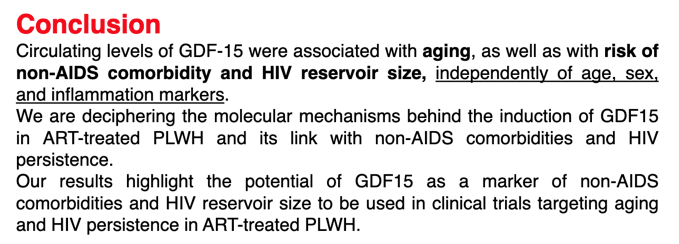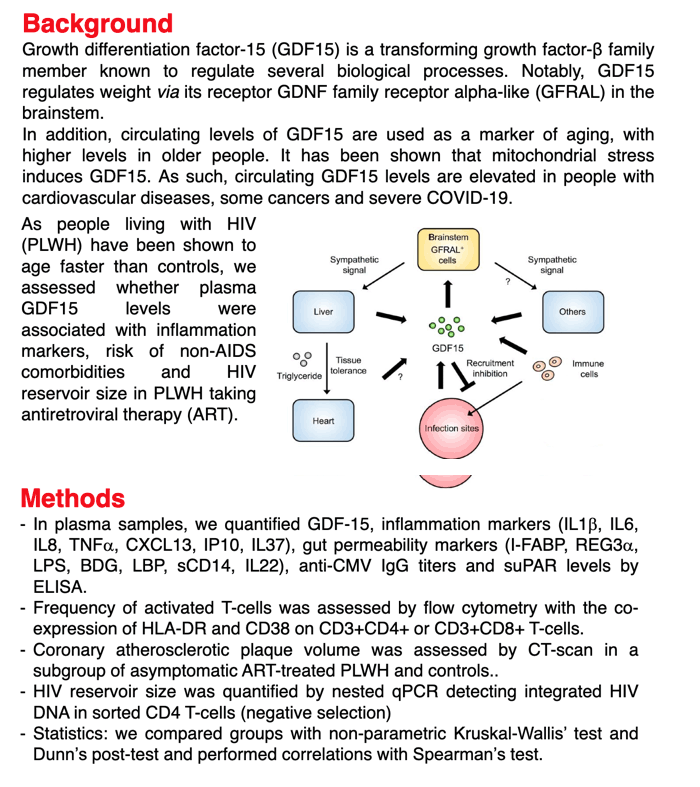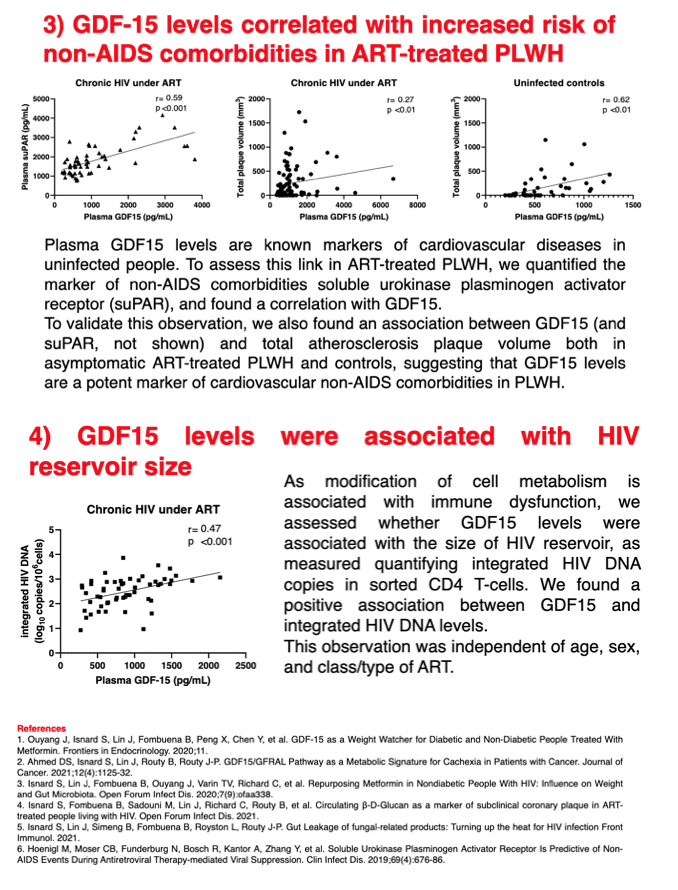 |
 |
 |
| |
Circulating GDF15 levels [cellular stress] are associated with aging, risk of non-AIDS comorbidities and integrated HIV DNA in ART-treated people living with HIV
|
| |
| |
IAS 2021 July 18-21
"Circulating levels of GDF15 are a marker of aging and mitochondrial cellular stress, elevated in people with cardiovascular diseases, cancer and severe COVID-19. GDF15 levels were higher in ART-treated PLWH compared to controls and were associated with risk of non-AIDS comorbidities and HIV reservoir size, independently of classical inflammatory markers. As cellular stress participates in faster aging, HIV reservoir size and non-AIDS comorbidities, further studies on GDF15 contribution are warranted in ART-treated PLWH."
"GDF15 correlated with age in both ART-treated PLWH and uninfected controls, suggesting increased levels of GDF15 as an indicator of faster aging in PLWH.
We found a positive association between GDF15 and integrated HIV DNA levels. This observation was independent of age, sex, and class/type of ART."
Presenter
Stephane Isnard
Authors
S. Isnard * (1), F.P. Dupuy (1), J. Lin (1), B. Fombuena (1), S. Bu (1), L. Royston (1), J. Ouyang (1), X. Peng (1), D. Sohail Ahmed (1), M. Kaur Pardesi (1), M. Durand (2), C. Tremblay (2), N.F. Bernard (1), J.-P. Routy (1).
Institutions
(1) McGill University Health Centre - Research Institute, Medicine, Montreal, Canada, (2) Centre Hospitalier de l''Universite de Montreal, Montreal, Canada

BACKGROUND: Growth differentiation factor-15 (GDF15) is a transforming growth factor-β family member known to regulate several biological processes. Circulating levels of GDF15 are a marker of aging and mitochondrial cellular stress, elevated in people with cardiovascular diseases, cancer and severe COVID-19. As people living with HIV (PLWH) have been shown to age faster than controls, we assessed whether plasma GDF15 levels were associated with inflammation markers, risk of non-AIDS comorbidities and HIV reservoir size in PLWH taking antiretroviral therapy (ART).
METHODS: Plasma and peripheral blood mononuclear cells (PBMCs) were obtained from ART-treated PLWH and age-matched uninfected controls. GDF15, validated markers of inflammation (IL1β, IL6, IL8, TNFa, IP10, CXCL13, sCD14), gut permeability (LPS, REG3a and IFABP) and non-AIDS comorbidities (soluble urokinase plasminogen activator receptor [suPAR]) were quantified in plasma samples by ELISA. Coronary plaque volume was assessed by CT-scan in ART-treated PLWH and controls. HIV reservoir size was quantified by measuring integrated HIV DNA by nested-qPCR in sorted CD4 T-cells.
RESULTS: PLWH were on ART for a median of 14.5 years and had undetectable viremia. Median age of PLWH and controls was 54 and 53 years, respectively. In PLWH compared to controls, plasma GDF15 levels were higher (p<0.0001) and correlated with age (r=0.4, p<0.01) and duration of infection. Type or class of ART did no influence GDF15 levels. In ART-treated PLWH, GDF15 levels were not associated with CD4 count, weight, gut permeability, disease progression nor inflammatory markers. GDF15 levels were also associated with levels of suPAR (r=0.68, p<0.0001, n=55) in ART-treated PLWH. In addition, GDF15 levels were associated with subclinical coronary atherosclerosis plaque volume in both ART-treated PLWH (r=0.27, p=0.009, n=90) and uninfected controls (r=0.62, p<0.001, n=40). GDF15 levels were also strongly associated with integrated HIV DNA levels (r=0.49, p<0.001, n=55) independently of age, sex, and CD4 count.
CONCLUSIONS: GDF15 levels were higher in ART-treated PLWH compared to controls and were associated with risk of non-AIDS comorbidities and HIV reservoir size, independently of classical inflammatory markers.
As cellular stress participates in faster aging, HIV reservoir size and non-AIDS comorbidities, further studies on GDF15 contribution are warranted in ART-treated PLWH.




|
| |
|
 |
 |
|
|